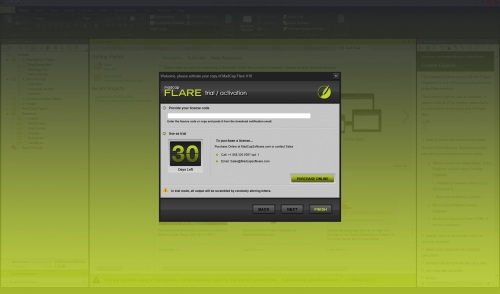Several weeks ago, on a day-off whim, I started watching the classic racing-anime series “Initial D” (1998) about a natural-born drift racer named Takumi and his 1980s Toyota AE86 Sprinter Trueno or “Eight-Six”. Immediately, I found myself being pulled into the passionate world of Japanese street racing. Before I knew it, several weeks later, I finished “Initial D: Fourth Stage” (2004-2006).
What does a Toyota AE86 have to do with MadCap Flare 10? In a word, passion! Just as Takumi’s natural attachment to his Toyota AE86 triggers his passion for downhill drift racing, my persistent fondness for MadCap Flare is fueling my passion for topic-based authoring outside of IBM. After all, overcoming difficult challenges is much more fun when you’re driven by some heartfelt passion.
Hi, my name is Jay, and I’m an IBM TRIRIGA information developer at IBM. In a previous post, I wrote: “When I attended my first local STC chapter meeting in September, I was exposed to Madcap Flare [9] for the first time too. Not only did the Flare demo impress me more than the Oxygen [15] demos, but ever since that presentation, I’ve thought about buying Flare for my own personal use.”
Why am I fond of MadCap Flare?
I can’t easily explain my peculiar fondness for MadCap Flare. Just like choosing a new car to buy, it’s not always about its function, but more often about its form. And the way a particular form moves you — whether it’s “cool” or “comfortable” or “smart” or “sexy” — or doesn’t move you, is unique to each of us, our preferences, and our circumstances. In my case, from the start, Flare felt “sexy”. :)
Don’t misunderstand me. When I say “sexy”, I don’t simply mean its slick black-themed ribbon menu. After test-driving the free 30-day trial version of MadCap Flare 10 for several days, I’ve found that its user interface is incredibly intelligent. Not only can I rearrange and save the Window Layout of my window panes, but the Dynamic Help content automatically shifts for the selected window pane!
Since September, one sexy feature that still stands out for me is the simultaneous split-screen views for both the XML Editor and Text Editor. Here’s my initial reaction from the same previous post.
- Breathing Oxygen XML in Windows 7 (27 Nov 2013)
Actually, comparing Oxygen to Flare is unfair. While Oxygen is a powerful XML editor, it’s still only an editor that’s an integral part of a larger single-source publishing package. Meanwhile, Flare is a single-source publishing package that includes its XML editor. So instead, based on my brief exposure to both Oxygen and Flare, I’ll compare their respective XML editors on the same level.
While there are many negligible differences between the two editor interfaces, one difference stands out the most for me. Compared to the Flare editor, the Oxygen editor lacks the ability to display alternate views for both formatted XML and plain text simultaneously. Whether or not this lack translates into an actual inconvenience in my everyday work remains to be seen.
Next, here are some sexy screenshots of the MadCap Flare 10 trial version, including the black ribbon menu, Start Page, Dynamic Help, and sample split-screen for the XML Editor and Text Editor.
How does MadCap Flare deal with DITA?
One of MadCap Flare’s strengths is its ability to natively import Microsoft Word documents, Adobe FrameMaker documents, Adobe RoboHelp projects, and DITA content, among other formats. Meanwhile, one notable criticism is its inability to natively edit DITA files. Fortunately, Flare mitigates this criticism with its ability to generate DITA output with reconverted DITA elements.
Notice how I didn’t pair “strengths” with “weaknesses”. While some writers who require full DITA support might judge this inability to edit DITA files as a weakness, many other writers who choose topic-based authoring might not require DITA support at all. In addition to Flare’s help topic about editing DITA styles, here are several articles that discuss how Flare deals with DITA.
- MadCap Flare 10: Editing DITA Styles (01 Mar 2014)
In this version of Flare, you cannot edit DITA files natively. However, you can edit style classes that result from imported DITA elements.
When you import content from DITA files, there is a one-to-one conversion that occurs. For each DITA element in your file, a style class is created in Flare as a result.
Example
Let’s say you have a paragraph-level DITA element called “topictitle,” after you import the file content, a style class called “h1.topictitle” might be created as a result in Flare. Or if you have a character-level DITA element called “cmdname,” after you import the file, a style class called “span.cmdname” might be created as a result in Flare. If necessary, you can edit those style classes in Flare. If you generate DITA output from your project, the style classes are converted back to DITA elements.
DITA Imports
I experimented with the samples in the DITA Open Toolkit, and MadCap Flare successfully imports a DITA project. The New Project > DITA Document Set command opens a wizard that guides you through the import process.
Although Flare 9 will import DITA projects, it is still not a full-fledged DITA editor, which means that if you need full DITA support, you will have to rule out Flare. But you can still do organized, structured, topic-based authoring without DITA, and Flare 9 is a very useful tool for both the development and production of various forms of content…
Overall Impression of MadCap Flare 9
My perception is that Oxygen may be a better choice for those who plan to be doing complex XML design and programming, or in need of full DITA support. But for the vast majority of technical writers, especially the ones faced with converting and managing legacy content, MadCap Flare 9 a great choice to manage help projects.
- Half-way DITA: Why some is better than none (06 Feb 2012)
The benefits of DITA, half-way
To us tech writers, the largest benefit of DITA, half-way, is that we can actually do it. We could not have gotten away with DITA, the full monty, which would have required a much longer project, a much bigger migration effort and hence, uncertain ROI.
For new topics, we are committed to writing them structured, so they follow the information model. To migrate legacy topics, we’ll have to ensure they have an identifiable topic type and a suitable heading, but we can cleaning up their insides in a “soft fade”, moving them towards structure one by one. This gives us a quicker win than cleaning up literally thousands of topics before having anything to show in the new method, model or system.
Summary
Flare’s current DITA support comprises the ability to import and generate DITA-based content. This could be useful to existing Flare users who wish to incorporate DITA-based content within their Flare projects. These users will need a separate DITA authoring tool to create and maintain the DITA-based source. In my view, the ability to generate DITA from Flare is less useful. Existing users of DITA may be attracted to Flare 5 as a means of publishing their DITA content to a range of formats including WebHelp, HTML Help and PDF. In a future version of Flare it may be possible to edit DITA-based content directly.
As you can see, based on these articles, many writers don’t judge this inability to edit DITA files as a weakness at all. On the contrary, I almost get the sense that many writers treat the DITA standard as a hindrance or nuisance. Luckily, as an IBM TRIRIGA information developer, I’ve become accustomed or acclimated to writing DITA content. But outside IBM, I understand the inconvenience.
Next, here are more sexy screenshots of the MadCap Flare 10 trial version, including the Import DITA Wizard, Target Editor for the HTML5 output type, and HTML5 Skin Editor for Web and Mobile.
What are my final thoughts?
After some thinking, I might be able to explain my peculiar fondness for MadCap Flare after all. Because “I’ve become accustomed or acclimated to writing DITA content” as an IBM information developer, it’s no longer a mysterious challenge to me. But after being exposed to a refreshing non-IBM non-DITA approach, Flare fueled my passion for topic-based authoring outside of my work.
In fact, several days with the MadCap Flare 10 trial version has fueled my interest even more. Sadly, I’ve confirmed with a MadCap sales representative that “MadCap would charge [me] the full amount of $799 up front” for a 12-month subscription, instead of charging me $67 per month. So, from the same previous post, my final thought still holds true: “If I only had enough spare cash.”
Finally, here’s another look at Takumi’s black-and-white Toyota AE86. Coincidentally, doesn’t its black racing stripes remind you of MadCap Flare’s sexy black-themed ribbon menu? I wonder. :)
Do I have an update?
One month later, I accelerated and gripped the uphill DITA road with Oxygen XML Author 15!
Related articles
- What’s new in oXygen XML Editor 15.2 (www.oxygenxml.com)
- Author-it and MadCap Flare comparison (www.justwriteclick.com)
- Learning to Love the Ribbon in MadCap Flare V8 (www.madcapsoftware.com)
- Madcap Flare Review: 45 Things I Love, 31 Things I Hate (www.idratherbewriting.com)


















